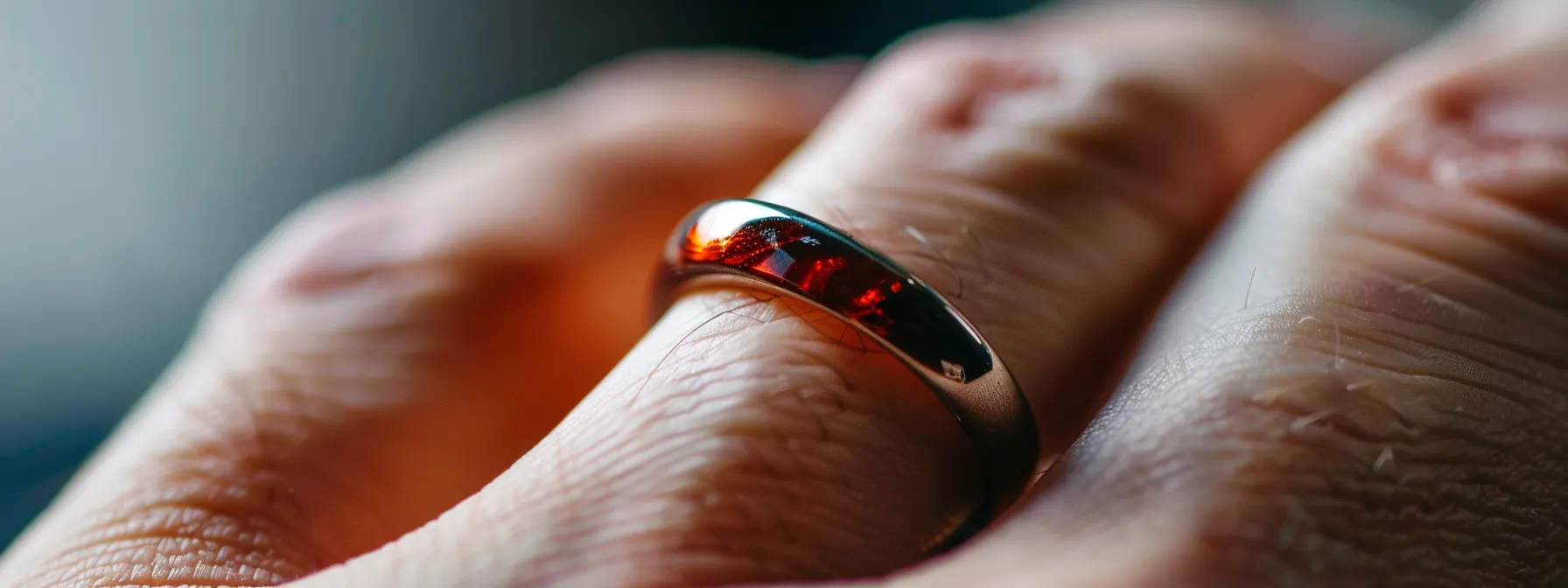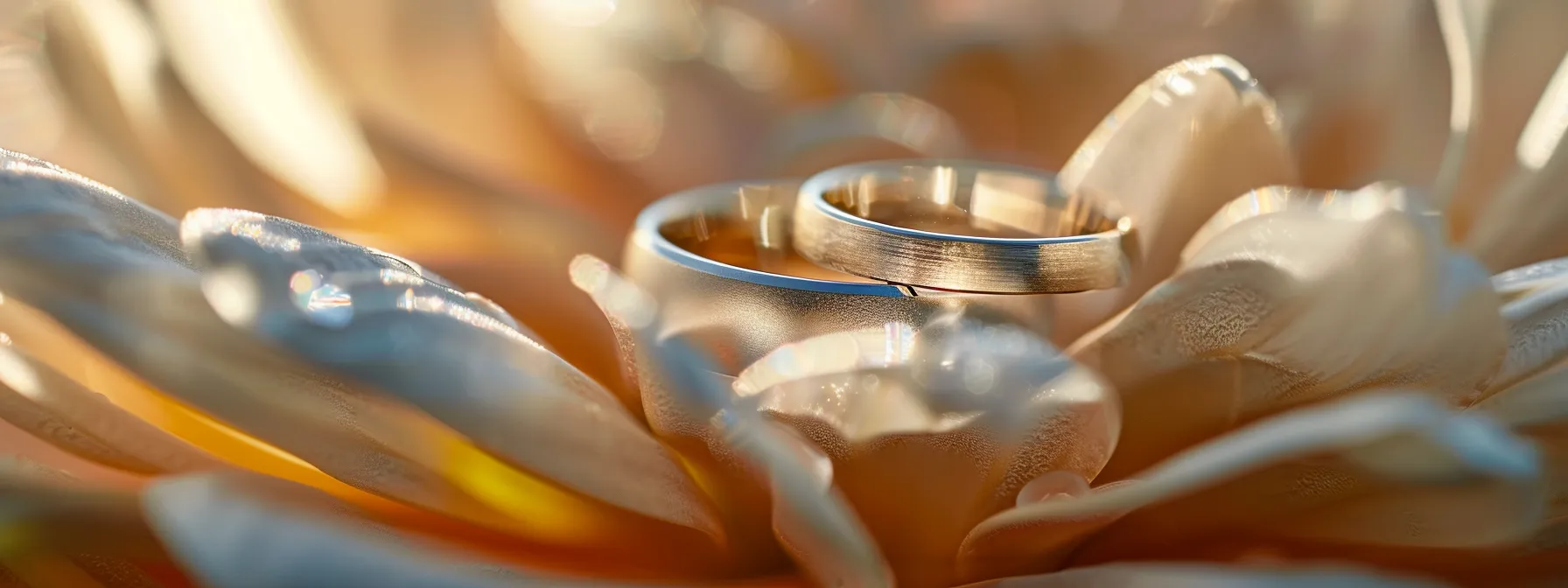Many people with sensitive skin struggle to find the right rings that won't cause irritation or reactions. If you have a nickel allergy, for example, choosing between tungsten and titanium rings can become a significant decision due to their differing alloys and densities. In this article, I'll explore how each metal affects sensitive skin, highlight their unique properties, and help you determine the gentler option for your needs. By understanding these differences, you can make an informed choice that keeps your skin comfortable and free from irritation.
Understanding Skin Sensitivity to Rings

Many people experience skin sensitivity when wearing rings, which can be triggered by common metals like nickel and cobalt. I often see symptoms of metal allergies, such as irritation and discoloration, affecting ring wearers. Understanding how metal composition affects these reactions is essential, especially when choosing between tungsten and titanium rings, as they differ significantly in their abrasive properties and overall suitability for sensitive skin.
Common Metals That Trigger Allergic Reactions
When discussing common metals that trigger allergic reactions, I frequently encounter nickel and cobalt as major culprits. These metals can cause irritation and discomfort when exposed to moisture on the skin, leading to inflammation or rashes. While some rings may incorporate these metals for durability, I always recommend checking the metal composition before making a purchase, especially if you have sensitive skin.
In my experience, other materials like platinum and zirconium present far fewer issues regarding skin sensitivity. Platinum boasts a natural lustre and is hypoallergenic, making it an excellent choice for those with skin sensitivities. Similarly, zirconium forms a protective oxide layer that enhances its compatibility with sensitive skin. By choosing these metals, you can often avoid the unpleasant effects that come from wearing rings made of more reactive materials.
Symptoms of Metal Allergies in Ring Wearers
As a specialist in men's rings, I often see various symptoms of metal allergies in ring wearers. Common signs include redness, itching, and a rash around the finger where the ring sits. These reactions can be particularly pronounced in individuals wearing rings made from materials like copper or sterling silver, which may contain allergenic metals that increase the risk of discomfort for sensitive skin.
When I consult with customers looking for alternative metal choices, I stress the importance of monitoring any changes after wearing a ring. Blistering, swelling, or discoloration can indicate that the metal's composition is causing an adverse reaction, compelling some to seek solutions like tungsten or titanium. Both materials tend to be more suitable for those with sensitive skin because they are less likely to provoke such issues, making them practical choices for long-term comfort.
How Metal Composition Affects Skin Reactions
The metal composition of a ring plays a critical role in how it interacts with sensitive skin. When I assess the differences between tungsten and titanium, I find that tungsten carbide, often reinforced with steel, can occasionally cause irritation due to its hardness and potential for abrupt edges. Titanium, on the other hand, is lighter and highly biocompatible, making it less likely to trigger an itch or discomfort. This is a crucial consideration for anyone with skin sensitivities.
Additionally, while some rings may utilize aluminum or other alloys, these can also lead to reactions. Over time, I've observed that high-quality titanium rings often come with warranties, assuring wearers of their durability and comfort. Laser engraving options are widely available and can personalize your ring without compromising its integrity, making titanium an exceptional choice for those concerned about skin reactions.
Skin sensitivity can be a quiet burden. Yet, there is relief to be found in tungsten rings—strong, durable, and kind to the skin.
Exploring Tungsten Rings for Sensitive Skin

When considering tungsten rings for sensitive skin, it's essential to look at their composition and alloys, which play a crucial role in their hypoallergenic properties. While tungsten rings are durable and heavy, they can sometimes trigger allergic reactions due to their hardness. In the following sections, I will explore the pros and cons of tungsten rings as a potential wedding ring choice for allergy-prone skin, helping you make an informed decision.
Composition and Alloys in Tungsten Rings
Tungsten rings are made primarily from tungsten carbide, which combines tungsten with metals such as chromium and vanadium to enhance their durability and strength. This composition makes tungsten rings resistant to wear and tear, meaning they hold up well against scratches and everyday damage. However, the hardness that gives tungsten its impressive durability can sometimes lead to discomfort for those with sensitive skin, as sharp edges may irritate the skin.
While tungsten itself is not typically allergy-inducing, the alloys used can impact its hypoallergenic properties. Some tungsten rings may contain nickel, which can provoke reactions in sensitive individuals. When choosing a tungsten ring for sensitive skin, I recommend seeking out those made with a pure tungsten carbide formulation, which is less likely to cause irritation and offers an appealing alternative to titanium for those who prioritize durability without sacrificing comfort:
- Tungsten carbide is combined with chromium and vanadium for strength.
- High resistance to wear and tear, making it ideal for daily use.
- Edges and sharpness may irritate sensitive skin.
- Look for rings with minimal alloying elements to reduce the risk of allergies.
Hypoallergenic Properties of Tungsten
Tungsten, particularly when combined with zirconium dioxide in its formulation, can exhibit hypoallergenic properties beneficial for those with sensitive skin. While tungsten itself is not inherently allergenic, the presence of certain alloys, such as nickel, can lead to metal allergies in susceptible individuals. I recommend seeking tungsten rings that emphasize a pure tungsten carbide composition to reduce the likelihood of irritation, providing a solution for those who prioritize both durability and comfort in their jewelry choices.
Price is often a consideration when exploring tungsten rings, as they tend to be more affordable than other options like platinum. However, incorporating features like inlays made from hypoallergenic materials can enhance both the aesthetic appeal and comfort. This approach allows you to enjoy the robust qualities of tungsten while minimizing the risk of skin reactions due to metal allergies, ensuring you find a ring that suits both your lifestyle and your skin sensitivity.
Pros and Cons of Tungsten Rings for Allergy-Prone Skin
In my experience, one of the significant advantages of tungsten rings for allergy-prone skin is their remarkable durability. Tungsten rings resist tarnish and scratches, making them an excellent choice for daily wear. Many brands offer optional engraving on tungsten, allowing for personalization without compromising durability. This means that not only can you enjoy a long-lasting ring, but you can also make it unique without worrying about excessive wear.
However, there are certain disadvantages to consider with tungsten rings. While they are less likely to scratch, the hardness of tungsten can create sharp edges that might irritate sensitive skin. Additionally, some tungsten rings may contain nickel, which can cause allergic reactions in susceptible individuals. To mitigate these concerns, I recommend seeking out tungsten options specifically marketed as hypoallergenic or those alloyed with niobium, a metal known for its compatibility with sensitive skin. Using a nail polish on the inner surface of tungsten rings might also help reduce skin contact with potential irritants, providing a temporary solution while still enjoying the strength and beauty of tungsten jewelry.
Tungsten rings offer strength but can sometimes irritate. Now, let’s turn our attention to titanium rings, known for their lightness and hypoallergenic qualities.
Assessing Titanium Rings for Skin Sensitivity

When assessing titanium rings for skin sensitivity, I focus on the purity and grades of titanium commonly used in jewelry. Titanium is highly biocompatible, meaning it rarely causes irritation, making it an ideal choice for sensitive skin. In the following sections, I’ll discuss the advantages of titanium rings, including their lightweight comfort and resistance to brittleness, while also addressing grey and gemstone options available to consumers.
Purity and Grades of Titanium in Jewelry
When assessing titanium rings for sensitive skin, it is crucial to consider the purity of the titanium used in jewelry. The most common grades include Grade 2 and Grade 5, with Grade 2 being commercially pure and less likely to irritate sensitive skin. I recommend looking for rings that specify their titanium grade, as this often indicates fewer alloying elements like iron that could provoke skin reactions.
Anodizing is another process that can enhance titanium's aesthetic appeal while providing an additional layer of protection against wear. This technique can change the color of the ring without compromising its hypoallergenic qualities. Moreover, options like laser engraving allow for personal touches without resorting to coatings or plating that might trigger sensitivities in individuals with delicate skin. By choosing high-quality titanium rings with these features, you can enjoy both style and comfort.
Biocompatibility of Titanium With Skin
When it comes to skin sensitivity, titanium stands out because of its exceptional biocompatibility. I often recommend titanium as a hypoallergenic option for those who have experienced discomfort with other metals. Unlike silver, which may contain alloys that can provoke reactions, titanium is less likely to irritate the skin. Its ranking on the Mohs scale, which measures mineral hardness, highlights its durability while still being gentle for wearers.
I have seen firsthand how titanium rings can be a more comfortable choice for people with sensitive skin. They don't provoke allergic reactions like some metals do, thus making them a smart option for everyday wear. Additionally, titanium is often compared to other materials like tantalum, which also maintains a high level of biocompatibility. This makes titanium an excellent choice for jewelry that can be worn all day without causing irritation or discomfort.
Advantages of Titanium Rings for Sensitive Skin
Titanium rings are an excellent choice for those with sensitive skin due to their high biocompatibility and low allergy potential. As a metal, titanium stands out for its remarkable toughness, which allows it to resist scratches and maintain its luster over time without the risk of tarnishing. This makes it a practical option for everyday wear, as it can easily endure various activities without causing irritation, unlike some precious metals that may react when exposed to moisture or body chemistry.
Moreover, titanium rings can be customized with materials such as opal or wood inlays, allowing for unique designs without sacrificing comfort. These additions create visually appealing rings while ensuring that the wearer remains comfortable throughout the day, as none of these materials typically provoke allergic reactions. I often suggest titanium rings for individuals who want a balance between style and practicality, making them a smart choice for anyone looking to avoid skin sensitivities while enjoying a durable, attractive ring.
Having assessed titanium rings, the next question arises: how does titanium compare to tungsten? Both metals boast durability, but which one proves gentler to sensitive skin?
Tungsten vs Titanium: Which Is Gentler on Sensitive Skin?

When comparing tungsten and titanium rings for sensitive skin, one important aspect to consider is their hypoallergenic qualities. I'll dive into skin test results that highlight how each metal reacts to moisture and soaps, which can lead to chemical reactions that impact wearers. Additionally, I will share real-life experiences from individuals with sensitive skin, providing practical insights into their comfort levels with tungsten versus titanium rings.
Comparing Hypoallergenic Qualities
When comparing the hypoallergenic qualities of tungsten and titanium rings, I often find that titanium alloys typically lead the way in terms of skin compatibility. Titanium is known for its biocompatibility, meaning it rarely causes skin reactions such as rashes, making it an excellent choice for those with sensitive skin. In my experience, even under various conditions like moisture or exposure to soaps, titanium maintains its integrity without provoking irritation.
On the other hand, tungsten rings, while durable and strong due to their carbon and tungsten carbide composition, may contain small amounts of nickel in the alloys used during manufacturing. This can potentially lead to allergic reactions in some individuals, particularly those who are sensitive to nickel. Choosing tungsten rings specifically marketed as hypoallergenic and free from problematic alloys is essential for those prone to reactions, ensuring a comfortable wearing experience.
Skin Test Results: Tungsten Versus Titanium
In my experience with skin test results for tungsten and titanium rings, I often observe that titanium demonstrates superior biocompatibility. In various tests, titanium consistently shows minimal reactions, even when exposed to moisture and soaps, making it a reliable option for those with sensitive skin. On the contrary, tungsten rings sometimes contain alloys with nickel, which can trigger allergic reactions in individuals susceptible to such metals.
Another aspect I find intriguing is the potential impact of coating like palladium, which some tungsten rings feature. While these coatings can enhance the aesthetic appeal of a tungsten ring, they may also contribute to skin sensitivity if worn frequently. For anyone considering their options, it's essential to evaluate the specific composition of both tungsten and titanium rings to ensure lasting comfort and avoid any adverse skin reactions. Here is a summary of key points to consider:
- Titanium shows minimal reactions in skin tests.
- Tungsten often contains nickel, which can cause allergies.
- Palladium coatings on tungsten may affect skin sensitivity.
- Choosing hypoallergenic options is crucial for comfort.
Real-Life Experiences From Sensitive Skin Wearers
In my conversations with customers who have sensitive skin, many share significant differences in their experiences with tungsten versus titanium rings. One individual recounted how switching to a titanium ring alleviated his ongoing discomfort, claiming that it felt lighter and did not irritate his skin like his previous tungsten ring. This firsthand account underscores titanium's reputation for being gentle on sensitive skin.
Another customer described her struggles with tungsten rings that contained nickel, which occasionally caused rashes and redness. After she opted for a titanium option, she noticed an immediate improvement. She expressed relief that the titanium ring not only offered a comfortable fit but also maintained its shine without the adverse skin reactions she had experienced before. These stories highlight the importance of selecting the right material when considering rings for sensitive skin, and they reinforce the overall advantages of titanium in this context.
Now that we've explored how both tungsten and titanium interact with sensitive skin, it's time to consider what truly matters. Choosing the right ring for your skin is not just a decision; it’s a step toward comfort and confidence.
Making the Right Choice for Your Skin

When choosing between tungsten and titanium rings for sensitive skin, it's important to consider several factors. I often suggest consulting with a dermatologist or allergist to better understand your specific sensitivities. Additionally, trying on rings before making a purchase can help ensure comfort and compatibility with your skin. These aspects play a significant role in finding the right ring that won’t cause irritation.
Factors to Consider Based on Skin Sensitivity
When choosing between tungsten and titanium rings for sensitive skin, I recommend considering your individual allergies and skin reactions. It's essential to understand which metals you may have sensitivities to, as not everyone's reaction is the same. For instance, if you're known to react adversely to nickel, this could sway your decision towards titanium, as it is typically nickel-free in its pure forms.
Another factor to consider is the ring's design and finish. I have found that smooth edges and polished surfaces minimize contact irritations, making them more comfortable to wear. Before making your purchase, it’s helpful to try on different styles to evaluate how they feel over time. Here’s a summary of key considerations for selecting a ring that suits your skin sensitivity:
- Identify your metal allergies.
- Opt for rings that are hypoallergenic.
- Try on various styles to assess comfort.
- Choose smooth designs to avoid irritation.
Consulting With a Dermatologist or Allergist
When selecting between tungsten and titanium rings for sensitive skin, consulting with a dermatologist or allergist can provide invaluable insights. These professionals can help identify any specific metal allergies you may have, ensuring that your choice aligns with your individual needs. Their expertise can guide you in understanding which metals to avoid, reducing the risk of discomfort or irritation after wearing a ring.
I often recommend that clients bring their previous experiences with skin reactions to these consultations. This information helps dermatologists or allergists determine patterns that may suggest a sensitivity to certain materials commonly found in rings. By understanding your unique skin sensitivities, you can make a more informed decision between tungsten and titanium, achieving both comfort and style in your ring selection.
Trying Out Rings Before Making a Purchase
When selecting a ring for sensitive skin, I always emphasize the importance of trying on various options before making a commitment. Visiting a store that offers both tungsten and titanium rings allows you to directly assess their comfort and fit. Pay attention to how each ring feels against your skin; sometimes, even slight variations in design can affect irritation levels.
Furthermore, taking the time to evaluate rings in person can reveal how different styles interact with your skin chemistry. I encourage clients to wear the rings for a while during their visit to determine if any discomfort arises. This firsthand experience can provide invaluable insights, guiding you to make a more informed choice between tungsten and titanium options that align best with your sensitivity needs.
Choosing the right ring for your skin is just the start. Next, let’s look at how to wear rings without discomfort, ensuring style and comfort go hand in hand.
Tips for Wearing Rings With Sensitive Skin

To ensure comfort for those with sensitive skin, I recommend focusing on proper ring maintenance to prevent irritation. Exploring alternatives to tungsten and titanium can also provide unique options tailored to your needs. If you notice any concerning skin reactions, it’s wise to seek professional advice. These considerations will help you maintain a pleasant wearing experience while selecting rings that complement your lifestyle.
Proper Ring Maintenance to Prevent Irritation
To prevent irritation when wearing rings, I always emphasize the importance of proper maintenance. Regularly cleaning your tungsten or titanium ring with mild soap and water can help remove any buildup of sweat, oils, or dirt that can cause skin discomfort. It's essential to dry the ring thoroughly after cleaning, as moisture trapped under the ring can lead to irritation or allergic reactions, especially for those with sensitive skin.
Additionally, I recommend checking your ring periodically for any signs of wear or rough edges, particularly with tungsten rings, which can develop sharp edges over time. If you notice any discomfort, consider using a clear nail polish on the inner surface of the ring to create a barrier between the metal and your skin. This simple step can often alleviate irritation, allowing you to enjoy your ring without worrying about skin sensitivity.
Alternatives to Tungsten and Titanium
When considering alternatives to tungsten and titanium, I often recommend stainless steel and ceramic rings. Stainless steel is durable, affordable, and generally hypoallergenic, making it a practical option for those with sensitive skin. Many of my clients have found that stainless steel rings hold up well against daily wear while providing comfort without irritation.
Ceramic rings are another excellent choice for individuals seeking hypoallergenic options. They are lightweight, available in various colors, and resistant to scratches. In my experience, clients who have transitioned to ceramic have reported a significant decrease in skin reactions, as these rings don't contain common irritants like nickel. These alternatives can beautifully combine style and comfort for anyone struggling with skin sensitivity.
When to Seek Professional Advice for Skin Reactions
If you experience persistent discomfort, redness, or swelling around your ring, it’s essential to seek professional advice. These symptoms could indicate an allergy or sensitivity that may require a dermatologist's expertise. I often recommend individuals to consult with a healthcare professional who can provide valuable insights and suggest suitable allergy testing if necessary.
Additionally, if you notice severe reactions, such as blistering or open sores, it's crucial to remove the ring immediately and reach out to a medical professional. In my experience, taking swift action can prevent further irritation and complications. It's also beneficial to keep notes on your experiences, including any specific metals or styles that seemed to trigger your reactions, as this information can assist healthcare providers in making informed recommendations:
- Seek help for ongoing irritation or discomfort.
- Look for signs of severe reactions and remove the ring promptly.
- Document your experiences with different metals and styles.
Conclusion
Choosing between tungsten and titanium rings for sensitive skin is crucial for ensuring comfort and preventing allergic reactions. Titanium, known for its exceptional biocompatibility and lightweight properties, often proves to be the safer option for those prone to irritation. In contrast, while tungsten rings offer durability, they may contain nickel and sharp edges that can exacerbate skin sensitivities. Ultimately, understanding your individual skin reactions and selecting hypoallergenic materials can lead to a satisfying and pleasant wearing experience.

